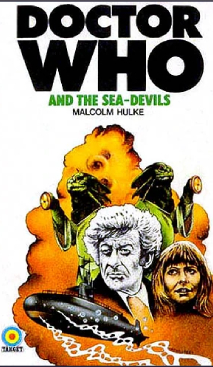
Synopsis: The Master has been tried and imprisoned with a ‘life-long’ sentence (commuted from a death sentence by the Doctor’s plea for mercy). When the Doctor and Jo visit him in his high-security home, they are only briefly reassured that he’s secure before he escapes and sets into motion a plan to resurrect more of the homo reptilia race – this time from beneath the sea.
Chapter Titles
- 1. ‘Abandon Ship!’
- 2. Visitors for the Master
- 3. The Vanished Ships
- 4. Stranded!
- 5. Air-Sea Rescue
- 6. ‘This Man Came to Kill Me!’
- 7. Captain Hart Becomes Suspicious
- 8. The Submarine
- 9. Visitors for Governor Trenchard
- 10. The Diving Bell
- 11. ‘Depth Charges Away!’
- 12. Attack in Force
- 13. Escape
Background: Malcolm Hulke adapts his scripts from the 1972 serial (the smallest gap so far between story transmission and novelisation, at two years, six months and two weeks).
Notes: It’s a little less even-handed this time as Hulke plays the Sea-Devils (not ‘Sea Devils’) as the aggressors from the start (and what a great opening scene as the crew of the ss Pevensey Castle abandon ship and are pulled under water one by one). Hulke also doesn’t give names to any of the Sea-Devils. There’s some background from the Master’s trial, where the Doctor begged for his best enemy’s life; although the death penalty was repealed for murder in the UK (except Northern Ireland) in 1965, it was still available for treason until 1998.
Governor George Trenchard’s backstory is elaborated upon to be both comical and rather tragic. The Doctor and Jo’s walk up to the chateau is given extra detail with the engraved wall-tap and the mysterious poem that reveals ancient local legends and somehow inspires the Doctor to deduce a pun on ‘the scales of justice’. The Master reveals that he’s worked with the Ogrons before (not in the TV version, but this was written soon after Frontier in Space, so would be fresh in the mind of the author and his audience). And the lead character is referred to as ‘Doctor Who’ twice.
Cover & Illustrations: The first cover by Chris Achilleos (a yellow maelstrom with the Doctor, Jo, two Sea Devils and a submarine). The first cover I owned was the 1979 John Geary reprint with the green and yellow Sea Devils and a bluey-pink background. The illustrations are once again by Alan Willow and my favourite is either the Doctor ducking as a Sea-Devil fires a heat ray or a Sea-Devil watching the submarine on TV.
Final Analysis: Another corker from Hulke. Even though the Sea-Devils are more overtly villainous than their cave cousins, they repeat their claim on the planet and at least appear to waver before going on the assault (stirred up by the Master). There’s the oft-quoted business about Trenchard wanting to be brave but being killed by Sea-Devils because he left the catch on his gun, and the Doctor switching it off before Captain Hart notices, but this is only one of many moments of charm for the characters – in fact if anything, it’s Jo who comes across worst, brash and impatient and occasionally compelled to back down when she gets too hot-headed.





